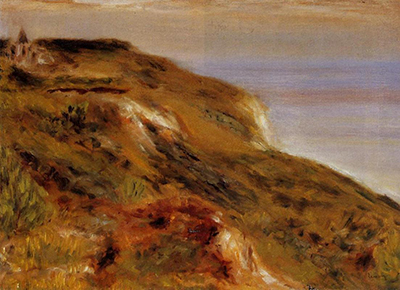The Varangeville Church and The Cliffs is an Impressionistic landscape oil painting by Pierre-Auguste Renoir, painted in 1880
The Varangeville Church and The Cliffs is a very loose, almost sketch-like painting using unusually subdued colours. Renoir is using a very dark palette here and he captures an almost Autumnal feel for the scene using mostly earth-tones such as yellow ochre and burnt umber.
These slightly dull but warm colours help to convey perfectly the various types of hardy vegetation that would struggle to survive in such a harsh environment as a North facing clifftop on the North Western coast of France.
The rich dark mass of the clifftops is brightened only by a suggestion of a strip of blue sky near the horizon giving the composition its balance.
A patch of light is visible in the warm coloured clouds and based on the geography of the location this would suggest the sun was in the West meaning the time was near sunset, the golden hour, when the landscape takes on the warm red hues of the setting sun.
As was often the practice of the Impressionists the painting was done on a white background and Renoir allows patches of the white of the canvas to almost show through allowing this brightness to suggest the erosion of the soil exposing the pale rock beneath.
The Varangeville Church and The Cliffs is notable for its large areas of smooth paint laid down with little sign of the trademark Impressionist brushwork, perhaps signaling Renoirs future shift to practising his art in a more traditional, classical style. This shift in technique would come after a trip he made to Italy in 1881 where Pierre-Auguste Renoir would be influenced by the great Renaissance artists such as Velazquez, Rubens and Raphael.
Renoir was becoming frustrated at the limitations of Impressionism and was at the same time aware that his income depended on the portrait commissions that were starting to come in. Renoir's Impressionistic method of portraying the skin of a face with dappled brushstrokes would not always produce the result he desired. Impressed with the beauty of the works of the Italian painters he was obviously inspired and began to experiment in implementing this stylistic technique into his own work.
Religious places of worship have long inspired artists, from the work in the Sistine Chapel of Michelangelo to the self-designed Rothko Chapel in the US. Vincent van Gogh also painted the Church at Auvers.
The Varangeville Church is in the Normandy region of France on the North Western coast facing the English Channel. A few miles west of Dieppe, the church and village were favoured by many artists of the day including Corot, Pissaro and Monet who did several Impressionist paintings there including The Fisherman's House and The Church. Pierre-Auguste Renoir discovered the area when staying as a guest at Paul Berards chateau in 1879 who was a patron of his, and would go on to paint the church at Varangeville again and also another landscape titled Landscape at Varangeville which he would paint in 1885.




